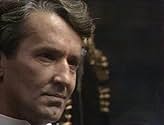अपनी भाषा में प्लॉट जोड़ेंLady Eileen "Bundle" Brent is a pert, aggressive young aristocrat that insinuates herself into a series of murders, stolen state secrets, and a mysterious secret society.Lady Eileen "Bundle" Brent is a pert, aggressive young aristocrat that insinuates herself into a series of murders, stolen state secrets, and a mysterious secret society.Lady Eileen "Bundle" Brent is a pert, aggressive young aristocrat that insinuates herself into a series of murders, stolen state secrets, and a mysterious secret society.
- Vera
- (as Henrieta Baynes)
कहानी
क्या आपको पता है
- ट्रिवियाFollowing the success of their version of Why Didn't They Ask Evans? (1980), the same production team reunited for this Agatha Christie adaptation, including Pat Sandys, Tony Wharmby and Jack Williams. Both productions also included the actors: John Gielgud, James Warwick, and Robert Longden.
- गूफ़The raised roman numeral for the "eleven" o'clock position on the hoods is reversed reading 'IX' instead of 'XI' during the first meeting shown. Later in the movie it is corrected, but they didn't make new hoods; instead they inked over the raised leading 'I' and added a gold paint 'I' after the 'X'.
- भाव
Marquis of Caterhan: Inconsiderate, that's what I call it, distinctly inconsiderate.
Lady Eileen 'Bundle' Brent: People have to die somewhere.
Marquis of Caterhan: Well they don't need to die in my house.
Lady Eileen 'Bundle' Brent: Lots of people have, masses of stuffy old great grandfathers and grandmothers.
Marquis of Caterhan: That's quite different. Of course I expect family to die here. But I do object to strangers!
- कनेक्शनVersion of The Seven Dials Mystery
This comes close in terms of Christiness. That's because it is a pretty faithful rendering of the book. As such, it follows her nice form of introductions. In these novels, it is all a game of defining people that sew into each other. The people come first and we find of course that by the end we have sewn them together incorrectly because of the simple order in which they were introduced.
Christie (and others, Sayers) have this game of limited watching. Everything we see is true, but we don't see everything we need to in order to weave a coherent narrative until the end. That's when we revisit many scenes, which we "see again." Its all about seeing, really. And that's especially so when she writes book without her regular detectives. With the detectives, there is some internal sight, some mental perspectives, but with these it is purely about what is seen physically.
Here's the interesting part. Movies, and especially these puzzle movies are also about what we see and what we don't. That's the root of the cinematic experience. But Christie didn't write with a cinematic imagination. So the two conventions of visual trickery are close but not the same.
That's why I'm so fascinated by films of Christie stories. It is a wonderful cinematic challenge for the filmmaker, and in a way because all this is collaborative construction one for the viewer as well.
This adventure plays with secrets in three ways (signage, association and "state" secrets) and allows us to confuse them by natural assumptions that prove false. It is clever. As a book it is clever, I mean.
As a film, it goes on too long and asks us to accept some rather extreme portrayals.
Even with its length and observance of the story, there is a pretty jarring discontinuity between the first part of a large group of young, silly people. We need this large number to justify the eight clocks. But managing so many red herrings in a movie isn't feasible so all the girls are dropped.
Ted's Evaluation -- 2 of 3: Has some interesting elements.
टॉप पसंद
विवरण
- रिलीज़ की तारीख़
- कंट्री ऑफ़ ओरिजिन
- भाषा
- इस रूप में भी जाना जाता है
- Das Geheimnis der sieben Zifferblätter
- फ़िल्माने की जगहें
- उत्पादन कंपनी
- IMDbPro पर और कंपनी क्रेडिट देखें
इस पेज में योगदान दें
































